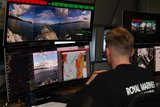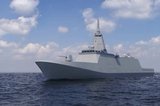BAE starts building second UK OPV
BAE Systems in Glasgow has started construction on the second Offshore Patrol Vessel (OPV) for the Royal Navy, the future HMS Medway, on 8 June.
The vessel is the second of three River Class Batch 2 OPVs, with construction of the first vessel, HMS Forth, well underway in Glasgow. The first OPV is due for delivery in 2017. The third vessel, HMS Trent, is expected to begin construction by the end of the year.
The OPV has a length of 90m, maximum speed of 24 knots and a range of over 5,000 nautical miles. It has a flight deck that can operate Merlin helicopters and larger stores and accommodation for troops.
The three vessels are the first to be built with BAE System's Shared Infrastructure operating system, which will be rolled out across the navy's surface fleet over the coming decade. The Shared Infrastructure system uses virtual technologies to integrate sensors, management and weapon systems in warships. It replaces multiple large consoles with a single hardware solution.
Michael Fallon, Defence Secretary, said: 'These new ships are an important part of the £160 billion we are investing over the next decade in the equipment our armed forces need. The contract will benefit the dedicated workers of the Clyde, their families and the local economy in Glasgow. And the investment will ensure these shipyards continue to develop into world class engineering facilities at the heart of a thriving British naval shipbuilding capability.'
Related Equipment in Defence Insight
More from Naval Warfare
-
![NATO tests use of “undetectable, jam-proof” laser communication in maritime scenarios]()
NATO tests use of “undetectable, jam-proof” laser communication in maritime scenarios
As part of its effort to better prepare its capabilities for operations in contested and congested scenarios, NATO evaluated a Lithuanian ship-to-ship terminal designed to not be susceptible to enemy interference.
-
![US Navy advances with the Harpoon Service Life Extension Programme]()
US Navy advances with the Harpoon Service Life Extension Programme
The US Navy plans to improve Harpoon’s anti-ship and land attack capabilities by equipping the missiles with sensors and technologies required for succeeding in future battlespace.
-
![Mitsubishi eyes future with Australia’s Mogami selection]()
Mitsubishi eyes future with Australia’s Mogami selection
With Australia’s selection of the Mogami-class for Project Sea 3000, Mitsubishi is investigating local production in the next decade as potential export opportunities emerge.
-
![Thales’ new Sonar 76Nano could equip UK Royal Navy on anti-submarine warfare missions]()
Thales’ new Sonar 76Nano could equip UK Royal Navy on anti-submarine warfare missions
The new sonar is designed to equip uncrewed underwater vessels, with the potential to be used by the Royal Navy for its Atlantic Bastion and Atlantic Net missions.
-
![Hanwha wins Australian government approval to increase its stake in Austal]()
Hanwha wins Australian government approval to increase its stake in Austal
The contract would mean the two shipbuilders can collaborate strategically and enhance shipbuilding capabilities in Western Australia.























